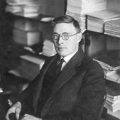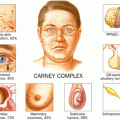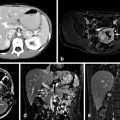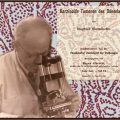Karl Hürthle (1914), deutscher Physiologe und Kreislaufforscher. Privatbesitz, Dr. Elisabeth Hürthle
Introduction
The cells Karl Hürthle initially described in dogs were actually C cells, i.e., he has long been wrongly credited with the discovery of oncocytic or “Hürthle cells” in the thyroid. In fact, in Germany, these cells are referred to as “Askanazy cells” in protest of the misattributed name, because it was actually endocrine pathologist Max Askanazy who first described the oncocytic cells of the thyroid gland [1, 2]. It was James Ewing who assigned the misnomer in 1919, in his monumental first edition of “Neoplastic Diseases,” in which he referred to large cells with abundant pink granular cytoplasm as “Hürthle cells,” thus propelling Karl Hürthle into endocrine medical history [3].
Early Life and Career
Karl Hürthle was born in Ludwigsburg, Germany on March 16, 1860. He studied Medicine at the University of Tübingen in Tübingen, Germany, one of Europe’s oldest universities founded in 1477. Hürthle received his MD in 1884 and was an assistant to Karl von Vierordt and Paul Grützner; the former is known for developing techniques for monitoring blood circulation and pulse oximetry and is considered integral in the development of the modern sphygmomanometer, while the latter is known for his work in circulatory physiology and the physiochemical behavior of pepsin in the digestive system [4, 5].
In 1887, Hürthle moved on to Breslau to become an assistant to Rudolf Heidenhain, who is known for his contributions to the understanding of muscle and nerve physiology. Hürthle then devoted the rest of his long career to his work at the Physiological Institute in Breslau, eventually replacing Heidenhain as professor and director of the Institute in 1898. In 1889, Heidenhain sent Hürthle to represent the city of Breslau at the first International Congress of Physiologists, and it was this scientific meeting that influenced Hürthle to continue in research in physiology [6]. The idea of an International Congress of Physiology had been introduced in 1867 at the first Congress of Medicine, and from September 10 to 12, 1889, Hürthle joined 128 other inaugural members in Basel, Switzerland, and was subsequently appointed to the Commission International pour unification des appareils enregistreurs, later known as the Institut Marey. The commission was suggested to the Congress by Étiene-Jules Marey, and it subsequently guided standardization of approved physiological instruments. In 1938, Hürthle wrote a congratulatory message for the 50th anniversary of the International Congress of Physiologists as one of few surviving members at that time [7]. Hürthle retired in 1927 and died in Tübingen in 1945 [6] .
Hürthle’s primary research interest in hemodynamics led to the study of blood viscosity in different living animals, for example, by measuring carotid flow through a calibrated tube [8]. He was also credited with early recordings of blood pressure in the circle of Willis and performed extensive research in the areas of blood pressure and vasodilation [9].
The Origin of “Hürthle” Cells
The saga of the so-called thyroid Hürthle cell began in 1876 when Baber described what we now know to be the calcitonin-containing C cells in dogs. Evidently unaware of Baber’s report, in 1894, also Hürthle published his findings of these same cells in canine thyroid glands [10, 11]. This was Hürthle’s sole publication related to thyroid disease. Though it did not actually describe oncocytic cells, his paper, written in German and entitled “Studies on the secretory activity of the thyroid gland” did expand upon some important questions regarding the secretory activity of follicular cells, the mechanism of thyroid hormone secretion, and the formation of thyroid follicles as summarized and translated by Caturegli [6].
In 1898, it was Max Askanazy who was actually the first to describe enlarged epithelial cells with abundant granular and eosinophilic cytoplasm resulting from accumulation of altered mitochondria in a patient with Graves’ disease [6, 12]—which today are inaccurately called Hürthle cells. The C cells that Hürthle had described have also been referred to as parafollicular cells, argyrophils, and light cells. C cells are smaller than oxyphil cells and are characterized by their interfollicular position, abundant dense granules, pale cytoplasm, numerous, large mitochondria, and absent Golgi apparatus [13]. Unfortunately, the differing identities were overlooked by James Ewing in his text Neoplastic Diseases when he referred to oxphylic cells as “Hürthle cells” [3]. The misapplied Hürthle eponym is used today worldwide except in Germany where these cells are referred to as Askanazy cells in protest.
Stay updated, free articles. Join our Telegram channel

Full access? Get Clinical Tree







